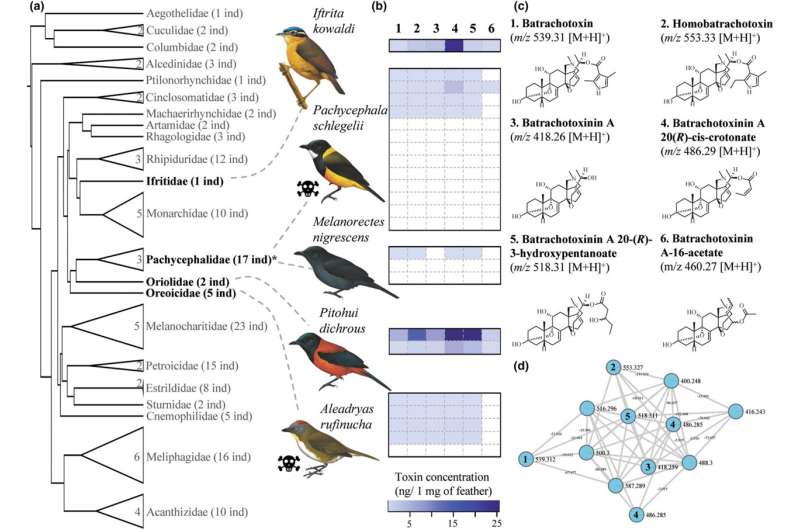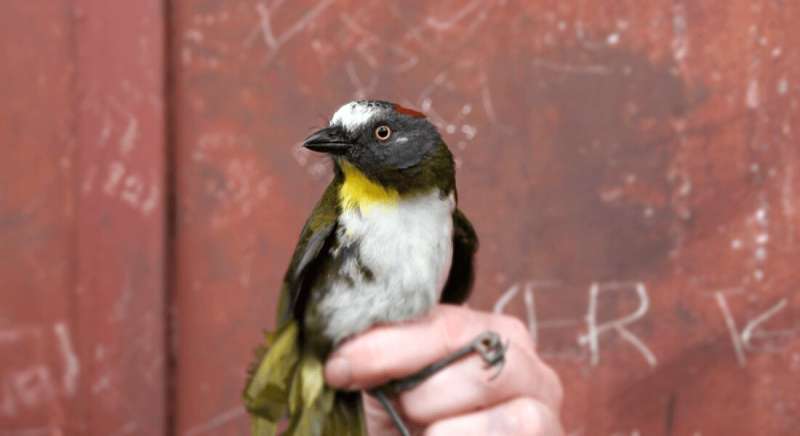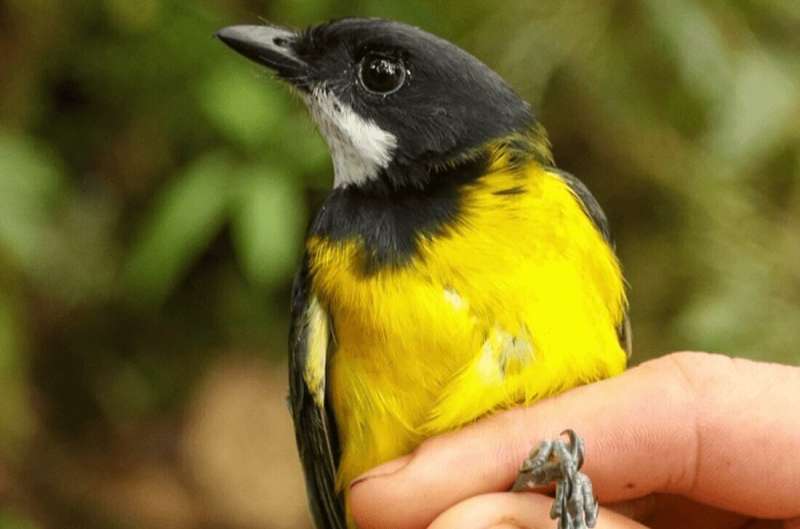This article has been reviewed according to Science X's editorial process and policies. Editors have highlighted the following attributes while ensuring the content's credibility:
fact-checked
peer-reviewed publication
trusted source
proofread
Researchers discover birds with neurotoxin-laden feathers in New Guinea

An expedition into the jungle of New Guinea has resulted in the discovery of two new species of poisonous birds by researchers from the University of Copenhagen. Genetic changes in these bird species have allowed them to carry a powerful neurotoxin.
The poisonous birds inhabit one of Earth's most pristine rainforests, a place as exotic as no other in the world. Hearing the words poisonous and bird coupled will be an eye-opener for most. But poisonous birds actually exist. And now, more species have been discovered in New Guinea's jungles.
"We managed to identify two new species of poisonous birds on our most recent trip. These birds contain a neurotoxin that they can both tolerate and store in their feathers," says Knud Jønsson of the Natural History Museum of Denmark.
Jønsson and fellow UCPH researcher, Kasun Bodawatta have been on an Indiana Jones-like research trip, risking life and limb to regularly warring tribespeople and ex-cannibals amidst the jaw-dropping biodiversity of New Guinea's rainforest. Here they captured two new bird species, each of which has developed the ability to consume toxic food and turn that into a poison of their own.

The two birds that the researchers discovered to be poisonous are the regent whistler (Pachycephala schlegelii), a species that belongs to a family of birds with a wide distribution and easily recognizable song well-known from across the Indo-Pacific region, and the rufous-naped bellbird (Aleadryas rufinucha).
"We were really surprised to find these birds to be poisonous as no new poisonous bird species has been discovered in over two decades. Particularly, because these two bird species are so common in this part of the world," says Knud Jønsson.
Neurotoxin causes muscle spasms
Most people are familiar with South and Central America's iconic poison dart frogs—especially the golden poison frog. These small, brightly colored amphibians can kill a human at the slightest touch. The discovery of the two new poisonous bird species in New Guinea, which carry the same type of toxin in their skin and feathers, demonstrates that the frog toxin is more widespread than once believed.
The poison in these birds' bodies and plumage is called Batrachotoxin. It is an incredibly potent neurotoxin that, in higher concentrations, such as those found in the skin of golden poison frogs, leads to muscle cramps and cardiac arrest nearly immediately after contact.
"The bird's toxin is the same type as that found in frogs, which is a neurotoxin that, by forcing sodium channels in skeletal muscle tissue to remain open, can cause violent convulsions and ultimately death," explains Kasun Bodawatta.
Like cutting onions, but with nerve agent
South America's poison dart frogs use their toxin to protect them from predators. Though the level of toxicity of the New Guinean birds is less lethal, it may still serve a defensive purpose, but the adaptive significance for the birds is yet uncertain.
"Knud thought I was sad and having a rough time on the trip when they found me with a runny nose and tears in my eyes. In fact, I was just sitting there taking feather samples from a Pitohui, one of the most poisonous birds on the planet. Removing birds from the net isn't bad, but when samples need to be taken in a confined environment, you can feel something in your eyes and nose. It's a bit like cutting onions—but with a nerve agent, I guess," laughs Kasun Bodawatta.
"The locals aren't fond of spicy food and steer clear of these birds, because, according to them, their meat burns in the mouth like chili. In fact that's how researchers first became aware of them. And the toxin can be felt when holding onto one of them. It feels kind of unpleasant, and hanging on to one for long isn't an appealing option. This could indicate that the poison serves them as a deterrence of those who would want to eat them to some degree," explains Jønsson.
An evolutionary arms race
According to the researchers, the poisonous birds are an expression of an everlasting evolutionary arms race in nature. It starts at the bottom of the food chain with beetles, insects and other invertebrates. Over time, some of these develop toxicity to avoid being eaten. Perhaps they also acquire a particular coloration that may serve as a warning. This in turn allow them to venture from their hideouts beneath logs and rocks.
"Then, a predator counters and suddenly, a bird species can eat them regardless. The predator too acquires a mutation that offers resistance to the toxin. This gives the bird an advantage and opens up a whole new food source that isn't available to its ecosystem competitors. So, there is clearly an arms race going on and the beetles will need to crawl back under that rock again until they've developed their next move a few million years later," explains Jønsson.
"Subsequently, the birds that have evolved the ability to eat toxic food, themselves become toxic and may be able to defend themselves against predators further up the food chain. And so, the race continues up the chain. It's evolution—anything can happen, but it often takes a long time," says the researcher.
Making the toxin their own
There is a distinction in biology between the two ways that animals deploy poisons. There are poisonous animals that produce toxins in their bodies and others that absorb toxins from their surroundings. Like the frogs, the birds belong to the latter category. Both are believed to acquire toxins from what they eat. Beetles containing the toxin have been found in the stomachs of some of the birds. But the source of the toxin itself has yet to be determined.
What makes it possible for these birds to have a toxin in their bodies without themselves being harmed? The researchers studied this with inspiration from poison dart frogs, whose genetic mutations prevent the toxin from keeping their sodium channels open, and thereby preventing cramps.

"So, it was natural to investigate whether the birds had mutations in the same genes. Interestingly enough, the answer is yes and no. The birds have mutations in the area that regulates sodium channels, and which we expect gives them this ability to tolerate the toxin, but not in the exact same places as the frogs," says Kasun Bodawatta.
He adds, "Finding these mutations that can reduce the binding affinity of Batrathotoxin in poisonous birds in similar places as in poison dart frogs, is quite cool. And it showed that in order to adapt to this Batrachotoxin lifestyle, you need some sort of adaptation in these sodium channels".
Therefore, these studies of the birds establish that while their neurotoxin is similar to that of the South American poison dart frogs, the birds developed their resistance and ability to carry it in the bodies independently of the frogs. This is an example of what biologists refer to as convergent evolution.
This basic research will primarily contribute to a better understanding of New Guinea's birds and how different animal species not only acquire a resistance to toxins but use them as a defense mechanism.
Other aspects of the research have the potential to help ordinary people. The toxin conquered by the birds over time is closely related to other toxins, such as the one responsible for shellfish poisoning.
"Obviously, we are in no position to claim that this research has uncovered the holy grail of shellfish poisoning or similar poisonings, but as far as basic research, it is a small piece of a puzzle that can help explain how these toxins work in cells and in the body. And, how the bodies of certain animals have evolved to tolerate them," says Knud Jønsson.
The expedition
Ten-meter-long nets stretch between poles in the middle of one of the world's most pristine and impassable jungles. Two tents are set up in a tiny rainforest encampment beside the nets. A few small logs have been chopped away at with machetes and fashioned into a rickety little table where a few items of research gear find protection from the rain under a tarpaulin brought along by the researchers.
"Life as a bird researcher in New Guinea is not exactly comfortable. It is hot, wet and even comes with a bit of anxiety from time to time. If you aren't prepared and haven't made agreements with the locals, going in cold can be downright dangerous," says Knud Jønsson from the Natural History Museum of Denmark.
The researchers received a government-issued permit to conduct research prior to their trip. But since the Papua New Guinean government does not own the forest land, it was crucial to contact, negotiate and come to an agreement with the people who live in the Saruwaged Range, where the study took place. This work was also facilitated by the New Guinea Binatang Research Centre, who has well-established connections with many villages in Northern Papua New Guinea.
"After landing the small propeller plane on a strip of dirt in the middle of the forest and far from much else, we moved ahead with machetes, hacking paths through the jungle with a group of local helpers," says Kasun Bodawatta.
"These people are cool. And as long as one respects their ways and takes care not to bother the spirits, they're really nice. The way they move through the forest in bare feet is truly impressive. Kasun and I were just moving around clumsily, tripping over roots in our big boots," laughs Knud Jønsson
Experience had taught them to remain vigilant in camp despite their agreement with the local tribal village.
"On a previous trip, we experienced ten men from a neighboring village suddenly standing in the camp with machetes—they can be (and regularly are) equally well used on vegetation and humans. They were angry and had a completely different perception of where the village boundaries were than the leaders of the tribal village with whom we had made the agreement," says Knud Jønsson of the Natural History Museum of Denmark.
This is why local collaborators are always involved in our work. Their inclusion have multiple aims. They help with practicalities and we transfer knowledge to those interested. However, they also serve an important purpose is to legitimize the presence of the researchers. Things can go horribly wrong if there are any doubts.
The rainforest is filled with small villages inhabited by a diversity of tribal people who often skirmish. Fifty years ago, such quarrels involved cannibalism. And while traditions of tribal enemies eating one another in Papua New Guinea were officially laid to rest a half century ago, there have been cases of "ex-cannibals" overstepping the law.
"What happens in the forest is difficult for the government to know much about. Of course that increases the tension for us. Conducting research in a environment where you need to have so much focus on safety is quite unique. But even though it can be tough, it's also everything you ever dreamed of as a biologist," says Knud Jønsson.
The paper is published in the journal Molecular Ecology.
More information: Kasun H. Bodawatta et al, Multiple mutations in the Nav1.4 sodium channel of New Guinean toxic birds provide autoresistance to deadly batrachotoxin, Molecular Ecology (2023). DOI: 10.1111/mec.16878
Journal information: Molecular Ecology
Provided by University of Copenhagen

















